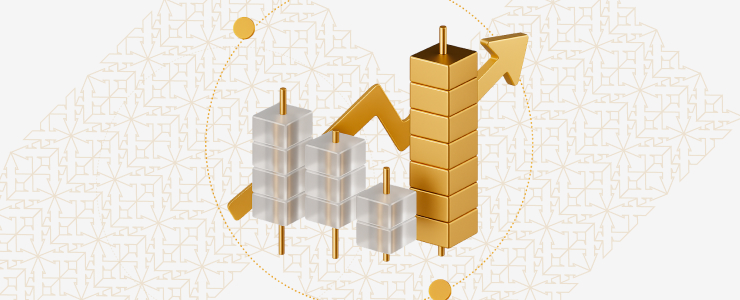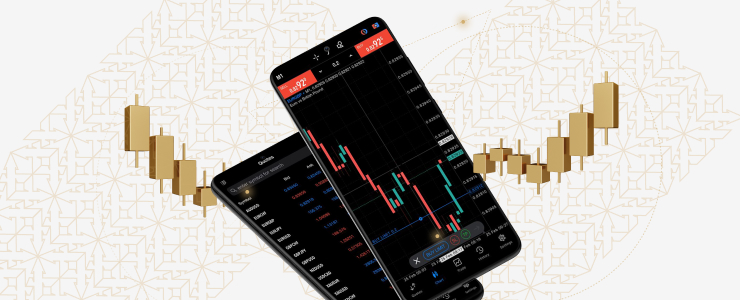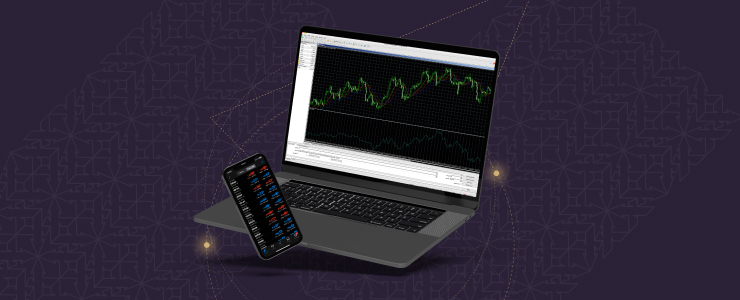CFD- und Devisenhandel liegen derzeit voll im Trend. Viele Trading-Mentoren, technische Analysten und Trader halten die Begeisterung am Leben, indem sie ihre Ansichten und ihre Begeisterung für die Märkte online in Foren, Webinaren und Podcasts teilen. Aber Erfolg im Devisenhandel oder die Vorstellung von großen Gewinnen kommen nicht über Nacht und sind nicht für jeden möglich. Die Vorstellung, dass Trader über Nacht „groß rauskommen” können, ist oft irreführend. Viele steigen mit unrealistischen Erwartungen und wenig Verständnis für die Funktionsweise des Handels und der Technischen Analyse in den Markt ein, obwohl gerade die Technische Analyse entscheidend ist, um fundierte Handelsentscheidungen zu treffen.
Eines ist sicher: Diejenigen, die es wirklich zu großem Erfolg gebracht haben, haben diesen nicht durch Spekulationen auf den Märkten, Glücksspiel oder Zufall erreicht. Stattdessen haben sie die Gelegenheit ergriffen und im Handel ihre Berufung gefunden, weil sie Zeit, Recherche und Wissen investiert haben.
Zunächst einmal erwarben sie ein tiefgreifendes Verständnis des Marktes, analysierten jeden Kursanstieg, jede Kerze und jede noch so kleine Veränderung der Dynamik. Ihre Fähigkeit, diese Hinweise zu erkennen und schneller als alle anderen darauf zu reagieren, zeichnete sie aus. Ihre Disziplin, ihre Fähigkeit, ihre Trades zu planen und zu timen und nicht aus dem Bauch heraus zu handeln, verschaffte ihnen einen Vorteil.
Hier kommt die technische Analyse ins Spiel. Erfahrene Trader verfügen über ein fundiertes Verständnis sowohl der technischen als auch der fundamentalen Analyse. In der technischen Analyse haben sie entdeckt, wie wertvoll es ist, Kurscharts, Muster und Indikatoren zu verwenden und zu verstehen. Gute Trader stürzen sich nicht in die Hoffnung, mit einem einzigen Trade Millionen zu verdienen. Sie studieren den Markt, um kurzfristige Chancen zu erkennen. Bei richtiger Handhabung können sich diese kleinen Bewegungen im Laufe der Zeit zu erheblichen Gewinnen summieren.
Technische Analyse hilft beim Verständnis der Preisentwicklung
Die technische Analyse ermöglicht es Händlern, die Kursentwicklung und -bewegungen der Vergangenheit zu betrachten, um zu antizipieren, was als Nächstes passieren könnte. Während sich die Fundamentalanalyse auf makroökonomische Daten konzentriert, konzentriert sich die technische Analyse auf den Kurs selbst und zeigt dessen aktuelle Richtung und potenzielle Trends auf.
Wenn Händler kaufen und verkaufen, verrät der Preis eines Vermögenswerts ihre Absichten. Er zeigt, worauf sich alle konzentrieren, was sie kaufen und warum. Unterstützungs- und Widerstandsniveaus zeigen, wo Händler in der Vergangenheit Maßnahmen ergriffen haben. Sie können auch dabei helfen, vorherzusagen, wo sich der Preis umkehren oder durchbrechen könnte.

Indikatoren und warum man sie in der technischen Analyse verwendet
Technische Indikatoren helfen Händlern dabei, zu bestätigen, ob ein Szenario wahrscheinlich ist, und dienen als Beleg für ihre Handelsthese. Obwohl Indikatoren die Analyse nicht ersetzen können, bieten sie eine zusätzliche Sicherheitsebene. Außerdem stärken sie das Vertrauen in die oft volatilen Märkte.
Die am häufigsten verwendeten Indikatoren in der Technischen Analyse sind gleitende Durchschnitte. Sie glätten Kursdaten, um Trends hervorzuheben und Tradern dabei zu helfen, sich auf aussagekräftige Signale statt auf Marktgeräusche zu konzentrieren. In der Technischen Analyse signalisieren sie Veränderungen in der Dynamik und können Trader warnen, wenn sich der Trend umzukehren droht.
Der Relative Strength Index (RSI) ist ebenfalls bei Tradern sehr beliebt und hilft dabei, zu messen, wie schnell und wie stark eine Preisänderung ist. Ein RSI unter 30 signalisiert oft einen überverkauften Markt, während ein Wert über 70 auf überkaufte Bedingungen hindeutet.
MACD (Moving Average Convergence Divergence) ist ein Momentum-Indikator, der die Beziehung zwischen zwei gleitenden Durchschnitten anzeigt. Wenn die MACD-Linie die Signallinie nach oben kreuzt, kann dies auf steigende Preise hindeuten. Wenn sie darunter fällt, signalisiert dies fallende Preise.
Indikatoren sollten jedoch in Maßen eingesetzt werden, da zu viele zufällige Indikatoren einen Trader verwirren und lähmen können. Am besten ist es, sich auf zwei oder drei Tools zu verlassen. Diese sollten gut zusammenwirken und zum Stil und Zeitrahmen des Traders passen.
Von klein bis groß
Mit CFD- und Devisenhandel können Händler selbst kleinste Kursbewegungen nutzen und davon profitieren. Der Einsatz von Hebeleffekten kann dazu beitragen, diese Bewegungen zu verstärken, aber auch zu größeren Verlusten führen. Daher ist es wichtig, sie mit Bedacht und Vorsicht einzusetzen und gleichzeitig ein solides Risikomanagement zu betreiben.
Trader, die sich in der technischen Analyse auskennen, können frühe Anzeichen eines Trends erkennen. Sie konzentrieren sich auf kleine Bewegungen, um den Trend zu nutzen, sobald er sich abzeichnet, anstatt ihm hinterherzulaufen.

Positionsverwaltung
Da niemand vorhersagen kann, wohin sich der Markt entwickelt, ist Skalierung eine kluge Strategie. Trader steigen schrittweise in einen Trade ein, anstatt alles auf einmal zu setzen. Sie können eine kleine Position eröffnen und diese erhöhen, nachdem sie weitere Bestätigungen erhalten haben. Dieser Ansatz hilft, Risiken zu reduzieren und gleichzeitig Geduld zu entwickeln, während sie abwarten und entsprechend handeln.
Durch sorgfältiges Skalieren können Trader kleine Bewegungen in größere Gewinne umwandeln. Es fördert Geduld und rationale Entscheidungsfindung.
Risikomanagement und technische Analyse
Technische Setups können fehlschlagen, da sich Märkte unvorhersehbar verhalten können, selbst wenn Trader ihre Recherchen durchgeführt und verschiedene Szenarien antizipiert haben. Was jedoch einen großartigen Trader von einem mittelmäßigen unterscheidet, ist die Art und Weise, wie er mit Verlusten umgeht.
Es ist eine kluge Strategie, festzulegen, wie viel Sie bereit sind zu verlieren – nicht mehr als 1–2 % Ihres Kapitals pro Position. So bleiben Sie auch nach Verlusten im Spiel und geben Ihren Strategien Zeit, zu wirken. Mit Stop-Loss-Orders können Sie einen Ausstiegspunkt festlegen, wenn sich der Markt gegen Sie entwickelt. Die Positionsgröße hält Ihr Handelsvolumen unter Kontrolle und stellt sicher, dass es Ihrer Risikotoleranz entspricht.
Der Schutz Ihres hart verdienten Geldes ist entscheidend und das Geheimnis professioneller Trader, die nicht aus einer Laune heraus Gewinnen hinterherjagen, sondern sich darauf konzentrieren, ihre Gelder so zu verwalten, dass dies langfristig konsistent und lohnend ist.

Verbesserung auf der Grundlage von Praxis und Erfahrung
Die technische Analyse ist ein großartiges Werkzeug in den Händen von Tradern, die wissen, wie sie sich anpassen und mit der Zeit gehen müssen. Mit der Entwicklung der Märkte ändern sich auch die Strategien, und kluge Trader lernen ständig dazu, testen und verfeinern ihre Strategien. In einem Umfeld, das sich ständig verändert, geht es beim intelligenten Trading darum, sich dem Markt anzupassen, flexibel zu sein und gleichzeitig sein Wissen zu erweitern und aus den Fehlern und Erfolgen der Vergangenheit zu lernen. Trader beginnen klein und arbeiten sich zu größeren Geschäften vor. Dabei sind sie ständig auf der Suche und bereit zu handeln.
Ein Trading-Tagebuch kann verwendet werden, um diese Trading-Reise von kleinen zu großen Chancen zu dokumentieren, indem alle Trades, die Gründe dafür und die verwendeten Indikatoren protokolliert werden. Ein Tagebuch wird dann zu einer unschätzbaren Informationsquelle, die auf Sie zugeschnitten ist, basierend auf Ihren eigenen einzigartigen Erfahrungen, Fehlern und Erfolgen, und Ihnen wertvolle Einblicke bietet und Ihnen hilft, sich weiterzuentwickeln.
Durch die Eröffnung eines Demokontos bieten viele Broker jungen Tradern und Anfängern die Möglichkeit, die Märkte zu erkunden, in ihrem eigenen Tempo zu lernen und ihre Strategie in die Praxis umzusetzen.
Aus diesem Grund ist beim Devisen- und CFD-Handel das Üben und Lernen ein fortlaufender Prozess, und sowohl Anfänger als auch erfahrene Händler lernen ständig dazu. Die technische Analyse ist ein großartiges Werkzeug für Trader aller Erfahrungsstufen und bietet zusätzliche Einblicke in die Märkte, sodass sie mit größerer Sicherheit bessere Entscheidungen treffen können. Die Fähigkeit, selbst kleinste Preisänderungen eines Vermögenswerts zu erkennen und zu interpretieren, ist ein großes Talent und eine wichtige Kompetenz, die Tradern, die auch konsequent Risikomanagement betreiben, dabei helfen kann, kleine Bewegungen in große Gewinne zu verwandeln.
Haftungsausschluss: Diese Informationen stellen keine Anlageberatung oder Anlageempfehlung dar, sondern sind als Marketingmitteilung zu verstehen.




